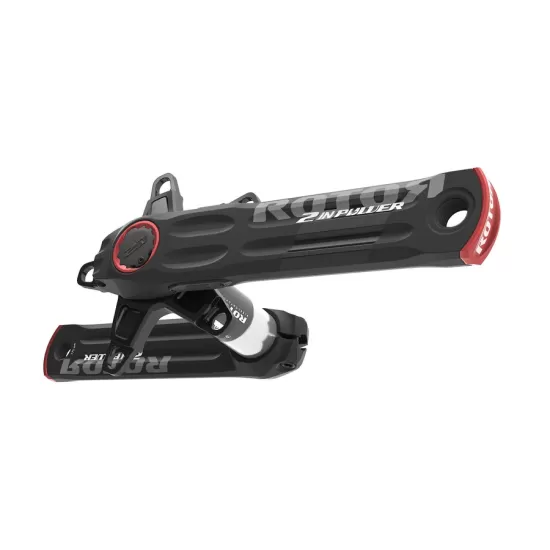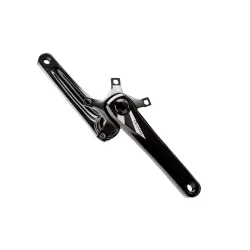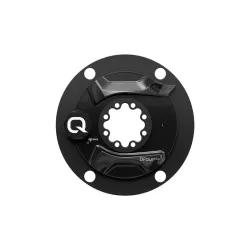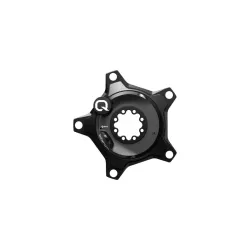Rotor 2INPower Crank
- Stock: In Stock
- Model: SG7462
- MPN: 01102136
Available Options
Rotor 2INPower Crank
Rotor brings a new direction to power meters with their 2INpower Crankset. This is an innovative crank-based two-sided measuring device that makes up for the deficiencies found in other power meters. With an accuracy that can’t be beat and a spider which can accommodate just about all 110mm bolt circle diameter chainrings, and the ability to work with non-round rings, the 2INpower is unique and welcome to the market.
If you’re wondering where the strain gauges are hiding, there are four inside the right crankarm and another four the axle. The axle also contains the motherboard and rechargeable battery, and the end cap the antenna. This internal placement of the gauges means that the unit isn’t temperature-sensitive, and the need to calibrate of adjust the offset is almost non-existent. You’ll do it on install of pedals, of chainrings, so you’ll do it when you first install the cranks, then after 30 hours of riding, and pretty much only when you re/install pedals or chainrings.
The crank measures both left and right side power-with the right arm measuring flexion and the axle measuring the torsion from the left arm. The ANT+ and Bluetooth Smart signals are sent from the cranks is on as long as the cranks are moving, which improves the accuracy of the power reading. Rotor puts the margin of error at less than +/- 1%.
There are additional benefits to the constant stream of data being sent out from the crank as you pedal. It’s one thing if you’re using round chainrings, as crankarm speed is fairly constant--though in low-cadence situations, the constant stream is a help-it’s another when you’re using non-round rings. Like Rotor’s Q and QXL rings. When you’re pedaling these rings, your crank speed is not constant, it constantly ebbs and flows. So accuracy with these rings is much greater. The data can be seen in some ANT+ equipped head units. But the real plus is when you utilize Rotor’s free software. You can use their Torque 360 graph to figure out which Rotor ring is best for your pedaling style, and exactly how to orient the rings, something Rotor calls OCA or Optimum Chainring Angle.
The software can be used to analyze your pedal stroke post-ride, but it also can be utilized during indoor riding sessions. You can watch in real-time your stroke and how small changes can affect power. There’s even an advanced training mode, where the samples sent from the crank double to enable greater precision for analysis.
There are two other metrics that are unique to Rotor that you can utilize to improve your pedal stroke and power output. This also can be found in the software. One is TE or Torque Effectiveness, which is a ratio o total torque divided by positive torque. The other is PS or Pedal Smoothness, which is average power divided by maximum power. Many times, getting more power is about pedaling better, not harder. And perfecting the stroke could be more valuable than squeezing greater power out of your body.
Rotor, as per their design thinking, works with 7055 aluminum as their material of choice. The crankarms are based off their 3D+ design, with unique machining in the right arm to fit the strain gauges. The right arm and axle are permanently affixed, while the left arm is loose and is the one you tighten on to the spindle.
The bottom bracket spindle is 30mm in diameter and is what Rotor refers to as UBB30. This means Universal Bottom Bracket. The size is stiffer than narrower bottom brackets and allows for both the electronics and the battery to be housed inside, where they are protected from the elements and minimize any increase in rotating weight. Rotor’s oversized spindle can work with threaded as well as press-fit bottom brackets. For English and Italian threaded bottom brackets, you’ll need an UBB bottom bracket, probably from Rotor. For the press fit standards, BB86, BB30, BB30A, BBright/BB386EVO, you should be able to purchase either the proper cups or bearings with the correct inner diameter.
Rotor makes the 2INPower available in the following crank lengths: 165, 170, 172.5, 175. The bolt circle diameter is 110mm. It’s primarily designed for road applications, though can certainly work for gravel and cyclocross, and the chainrings, be they single or double, which are designed for those disciplines Weight for the 172.5 crankset is 645g without chainrings, bolts, or bottom bracket.
The rechargeable battery is inside the axle and remains there for the life of it. It should last about 250 hours under normal conditions. No need to top off when you first install the crank. Charging is done via a 125cm long magnetic head cable that attaches to the crank on one end and a USB plug on the other. There’s a light in the crank that indicates battery life, going from green to yellow to red. When power is low, it will send a signal out that most ANT+ head units can read warning of low battery power. The battery is designed to survive 300 charging cycles, so it would be about 75,000 hours of riding before you’d need to worry (75k hours means if you rode two hours a day, every day for almost 103 years, you’d exhaust the battery)
The cranks come in a box with a bolt to install the left arm, the charger cable, installation manual, software manual, and a postcard for using TrainingPeaks at a discount. The software works with Mac OSX 10.7 and newer, Windows 7 and newer. A smartphone app is in the works as well.
The Rotor 2INpower crankset brings precision, low weight, and smart thinking to crank-based power meters.















